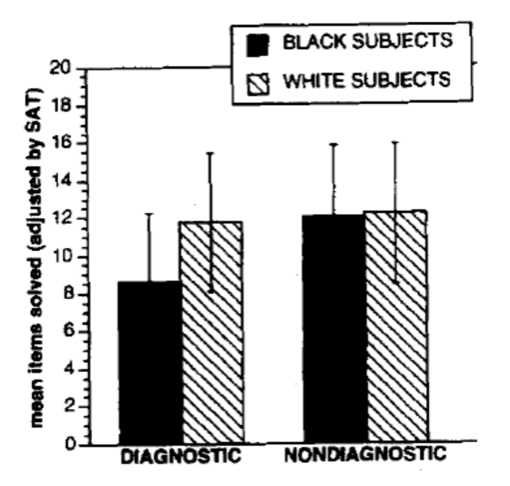Stereotype effect
1/10
Earn XP
Description and Tags
Studies
Name | Mastery | Learn | Test | Matching | Spaced |
|---|
No study sessions yet.
11 Terms
Steele and Aronson (1995) Terms to define
Stereotype
Stereotype threat
Steele and Aronson (1995) Aim
To se how sterotype threat affects test performance in African Americans
Steele and Aronson (1995) Procedure
Sample of 114 male and female, black and white students
Two independent variables: 1. The race of the participant, 2. The test descriptions
The participants were given a standardized test of verbal ability (similar to the SAT)
They were told one fo two things: 1. “It is a test to diagnose your intellectual ability” 2. “It is a test of your problem-solving skills”
In the first condition the focus was on ‘verbal ability’
In the second condition the focus was on ‘problem solving
Randomly assigned to one of the two conditions, while making sure there was an equal amount of participants in each
Steele and Aronson (1995) Results
THE GRAPH SHOWS THE MEAN TEST SCORES UNDER EACH CONDITION
There was no significant difference between male and female participants (gender not included)
African Americans did poorly when they believed that the test of their verbal ability (performed worse than their white counterparts when in a stereotype threat condition)
African Americans did just as good as the White Americans when they believed that the test was of their problem solving skills (in the non-threat condition, their performance equaled their white counterparts)

Steele and Aronson (1995) Evaluation
The exact mechanism underlying differences in achievement between black and white individuals (specifically students in evaluation scenarios) is yet to be fully understood, however viable posibilities exist
One of the most convincign possible explanation is the notion of a sterortype threat present in the scenario
Martin and Halverson (1983) Terms to define
Enculturation
Schema
Stereotype
Stereotype threat
Martin and Halverson (1983) Aim
To investigate the role of gender schema on a child’s ability to recall infromation that was not consistent with their gender schema
Martin and Halverson (1983) Procedure
Sample of 48 young children all enrolled in local kindergartens
They were given a test (SERLI) to assess their level of gender stereotyping prior to the experiment
Then, they were presented with 16 pictures, featuring males and females in activities that are either in line with gender schemas (e.x. a girl playing with a doll) or inconsistent with gender role schemas (e.x. a girl playing with a toy gun)
They were asked to identify the sex of the person in the picture (man, woman, boy or girl)
They were not told that they had to remember the images
A week later they were asked to remember what they saw in the pictures (probed recall procedure)
They were asked about the pictures they already had seen and 8 new ones they hadn’t (the 8 new ones were included to test for response bias)
Children were asked “Do you remember seeing a picture of something doing (activity) in the pictures I showed you last week?
Then, they asked them if the person they remember seeing was a girl, boy, man, woman or ‘don’t remember’
Also asked to rate their level of confidence on a four-point scale
Martin and Halverson (1983) Results
For pictures with female actors, activities consistent with gender stereotypes, were more often rememberd than inconsistnt activities
For pictures with male actors, activities inconsistent with the stereotypes were remembered more
Male stereotyping is more defined and rigid than for females in this population
Regardless of their level of stereotyping, children had distorted memories od pictures that were inconsistent with the gender stereotypes
Children were more confident and had less distortion of memory when the stories were consistent with their gender schema
Martin and Halverson (1983) Evaluation
Supports theory that stereotypes affect both encoding and retrival of information
There were erros made by children that made the sex consistent with gender stereotypes
Not completely generalizable to the entierty of the population due to chanages in individual stereotype schemas
Stereotype effect and studies general evaluation
Ecological validity
The inability to actually observe cognitive processes
Stereotype research has not shown a high level of reliability